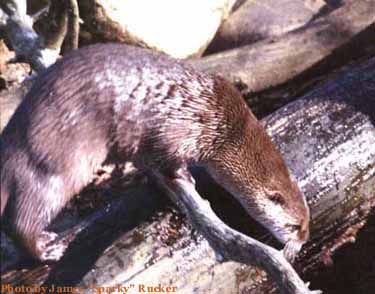Otter's Grandchildren, a Tale of Success By Rhonda H. Rucker
The animals wanted to hold an honor dance for the creature with the most beautiful fur coat. After meeting at the great council, they decided the honor should go to Otter. Rabbit was sent to notify Otter and to lead him to the dance. On the way back, Rabbit tricked Otter into camping at a so-called sacred place where fire falls at night. To protect his coat, Otter needed to remove it and hang it on a far-off tree. In addition, he needed to sleep next to the river in case he caught on fire. After Otter fell asleep, Rabbit created a firestorm by throwing hot coals in the air above Otter. During the resulting chaos, Rabbit ran off with Otter's coat. Otter dove into the river, where he discovered the delights of swimming, and he's been there ever since. Otters were plentiful in the area surrounding the Great Smoky Mountains until the 1930s, when trapping and poor logging practices resulted in its complete disappearance from East Tennessee. Otters remained absent until 1986. The Tennessee Wildlife Resources Agency , along with the National Park Service and other organizations, launched an ambitious project in 1986 to restore river otters in the eastern two-thirds of Tennessee and the Smoky Mountians. William Minser, research associate and instructor in the Department of Forestry, Wildlife, and Fisheries at the University of Tennessee, worked closely with students in the project. Minser says that some of the otters came from the Noose River in North Carolina. Other otters, however, came from Leroy Sevin, an old-time fur trapper in Louisiana. Sevin trapped otters to sell the hides until he found that he could make more money selling live otters to wildlife programs. Several states were buying from him, and he received about $200 to $300 for each otter. In contrast, one otter pelt only brought $30 to $70. Minser says a total of 487 river otters were reintroduced during the 1986-1994 period in Tennessee. This does not include 50 otters that were released in the Great Smoky Mountains National Park on the North Carolina side. During the first phase of the program, otters were brought to Abrams Creek. Later, they were released in other streams, including the Little River and West Prong. Nancy Gray, a park ranger in the Great Smoky Mountains National Park, says a total of 137 otters were reintroduced to the park itself during the eight-year span. During the first year of the project, radio transmitters were implanted surgically into the abdomen of each otter. Otters can travel up to about 50 miles in one day. Minser tells about one amazing otter who was tracked from the Little River on the Tennessee side of the Smokies traveling into the mountain streams. He then went over the crest of the mountains into the Fontana region on the North Carolina side of the range. This was surprising not because of the distance, which may not have been much more than 50 miles, but because he had crossed over the rugged terrain of the entire park. Otters are no longer tracked, but employees and visitors in the Smokies continue to report sightings of otter pups, says Gray. Bill Stiver, a wildlife biologist at the park, says that people fishing in the Fontana area have occasionally found otters rummaging in their minnow buckets. People don't seem to mind since the animals are usually amusing to watch. Otters have been known to go "sledding" down muddy slopes or icy hills just for fun. In 1998, the Tennessee Wildlife Resources Agency decided to conduct a state-wide survey of the streams, looking for the presence of otters and beavers. After the University of Tennessee became involved in this survey, much of the responsibility for the collection of data fell into the hands of Creig Kimbro. Kimbro was then a senior at UT, majoring in Wildlife and Fisheries Science. The members of the University of Tennessee Wildlife and Fisheries Society also provided invaluable assistance, he says. Kimbro's team looked for evidence of otters, including tracks, scat (feces), signs of feeding. Kimbro says it is relatively easy to spot signs of otters. One interesting, though admittedly unappealing, characteristic of a community of otters is that there will be a "latrine site," a nearby ten-foot span of land used for defecation. The results of Kimbro's work, which were released in 1999, showed that otters were present in 81% of the 32 streams that were surveyed. "Now," says Minser proudly, "you can go out on places like Chilhowee Lake or the Holston River and see otters again." According to the Cherokee legend, Otter did eventually get his coat back. As Gayle Ross, a Cherokee storyteller says, " . . . if you are looking for Otter's grandchildren, look in the rivers and the lakes and the streams. Because all the otters are living there still." Only 15 years ago, if Ross had been telling that story, she would have been wrong.
Copyright © The Southerner 2000.  |


